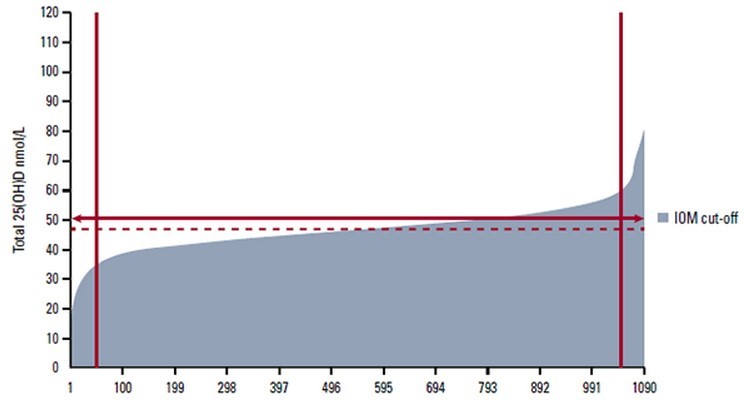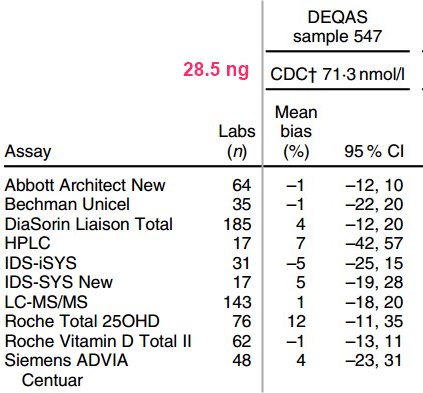4 popular vitamin D testers gave very different results (no surprise)
Comparison of four routinely used vitamin D automated immunoassays
J Med Biochem . 2021 Jun 5;40(3):277-285. doi: 10.5937/jomb0-27531.
Jindra Windrichova 1, Pavel Broz 1, Radka Fuchsova 2, Ondrej Topolcan 1, Ladislav Pecen 1, Otto Mayer 3, Radek Kucera 1
1 University Hospital Pilsen, Department of Immunochemistry Diagnostics, Czech Republic.
2 University Hospital Pilsen, Institute of Clinical Biochemistry and Hematology, Czech Republic.
3 University Hospital Pilsen, Second Internal Clinic, Czech Republic.

 * Vitamin D measurements vary from the same blood sample – March 2014 **poor repeatability * *
* Vitamin D measurements vary from the same blood sample – March 2014 **poor repeatability * *  1. # Opinion: Due to both accuracy and repeatability variations a Vitamin D test should never be trusted to be within 5 ng 1. Tests for Vitamin D contains the following overview/opinion{include}---Note: For many years there has been an attempt at standardizing Vitamin D measurments used for research It appears that most hospitals/testing facilities are not "standardized"
1. # Opinion: Due to both accuracy and repeatability variations a Vitamin D test should never be trusted to be within 5 ng 1. Tests for Vitamin D contains the following overview/opinion{include}---Note: For many years there has been an attempt at standardizing Vitamin D measurments used for research It appears that most hospitals/testing facilities are not "standardized" * *📄 Download the Standarization PDF from Vitamin D Life * *
* *📄 Download the Standarization PDF from Vitamin D Life * * 📄 Download the PDF from Vitamin D Life
Background: To compare four automated immunoassays for the measurement of 25(OH)-vitamin D (25-OHD) and to assess the impact on the results obtained from a healthy population.
Methods: We analysed 100 serum samples on Unicel DxI 800 (Beckman Coulter), Architect i1000 (Abbott), Cobas e411 (Roche) and Liaison XL (DiaSorin). Passing-Bablok regression and Bland-Altman plots were used for method comparison. In order to categorise the obtained values, results were categorised into the following groups: 0-25 nmol/L, 25-50 nmol/L, 50-75 nmol/L and above 75 nmol/L and compared. The percentage of samples below 75 nmol/L, and below 50 nmol/L was then calculated for every method.
Results: According to paired comparisons, each method differs from others (p<0.0001) except Cobas vs Architect, which do not show a statistically significant difference (p=0.39). The strongest correlation was found between Liaison and Architect (ρ=0.94, p<0.0001).
The percentage of samples below the recommended value of 75 nmol/L were:
| 70% | Architect |
| 92% | Liaison |
| 71% | Cobas |
| 89% | Unicel |
The percentage of samples below the value of 50 nmol/L were:
| 17% | (Architect) |
| 55% | (Liaison), |
| 28% | (Cobas) |
| 47% | (Unicel). |
Conclusions: The observed differences stem from the use of different analytical systems for 25-OHD concentration analysis and can result in different outcomes. The recommended values should be established for each assay in accorda
